Marine fish
-
Greyharbour mullet 200+
Read MoreThe mullets or grey mullets are a family (Mugilidae) and order of ray-finned fish found worldwide in coastal temperate and tropical waters, and in some species in fresh water. Mullets have served as an important source of food in Mediterranean Europe since Roman times. The family includes about 80 (at least 73) species in 25 genera.
Mullets are distinguished by the presence of two separate dorsal fins, small triangular mouths, and the absence of a lateral line organ. They feed on detritus, and most species have unusually muscular stomachs and a complex pharynx to help in digestion. -
Greyharbour mullet gutted 300+
Read MoreThe mullets or grey mullets are a family (Mugilidae) and order of ray-finned fish found worldwide in coastal temperate and tropical waters, and in some species in fresh water. Mullets have served as an important source of food in Mediterranean Europe since Roman times. The family includes about 80 (at least 73) species in 25 genera.
Mullets are distinguished by the presence of two separate dorsal fins, small triangular mouths, and the absence of a lateral line organ. They feed on detritus, and most species have unusually muscular stomachs and a complex pharynx to help in digestion. -
Sea bream 300/400 gutted
Read MoreThe seabream is a species of Sparidae fishes. They are recognisable by their oval compressed body and jaws containing 4-6 rows of slender teeth which are larger at the front. They are silvery in colour with blue and pink tinges and broken longitudinal gold lines. They can reach a maximum size of 60 cm in length. They live in northern Europe and in the Mediterranean, usually found on the inshore shelf at depths varying from 5 to 300 m. They are usually found in schools feeding on seaweeds and invertebrates. They breed in February to May leaving eggs in the demersal zone.
-
Sea bream 300/400
Read MoreThe seabream is a species of Sparidae fishes. They are recognisable by their oval compressed body and jaws containing 4-6 rows of slender teeth which are larger at the front. They are silvery in colour with blue and pink tinges and broken longitudinal gold lines. They can reach a maximum size of 60 cm in length. They live in northern Europe and in the Mediterranean, usually found on the inshore shelf at depths varying from 5 to 300 m. They are usually found in schools feeding on seaweeds and invertebrates. They breed in February to May leaving eggs in the demersal zone.
-
Sea bream 400/600
Read MoreThe seabream is a species of Sparidae fishes. They are recognisable by their oval compressed body and jaws containing 4-6 rows of slender teeth which are larger at the front. They are silvery in colour with blue and pink tinges and broken longitudinal gold lines. They can reach a maximum size of 60 cm in length. They live in northern Europe and in the Mediterranean, usually found on the inshore shelf at depths varying from 5 to 300 m. They are usually found in schools feeding on seaweeds and invertebrates. They breed in February to May leaving eggs in the demersal zone.
-
Sea bream 600/800
Read MoreThe seabream is a species of Sparidae fishes. They are recognisable by their oval compressed body and jaws containing 4-6 rows of slender teeth which are larger at the front. They are silvery in colour with blue and pink tinges and broken longitudinal gold lines. They can reach a maximum size of 60 cm in length. They live in northern Europe and in the Mediterranean, usually found on the inshore shelf at depths varying from 5 to 300 m. They are usually found in schools feeding on seaweeds and invertebrates. They breed in February to May leaving eggs in the demersal zone.
-
Dorade Rose gutted
 Read More
Read MoreFish species in the Sparidae family. In Japan, Pagrus major is known as madai and is prized both for its flavor and for its traditional use as an auspicious food, often served at New Year's and at festive occasions such as weddings. In Korea, it is known as Ch'amdom. Pagrus major is also the most commonly eaten fish in Taiwan. This fish is grilled over charcoal or wood fire in Spain and known as besugo.
It is widespread in the Northwest Pacific from the northeastern part of South China Sea (Philippines excluded) northward to Japan. It is a marine subtropical oceanodromous demersal fish. -
Atlantic Cod fillet without skin 400/600
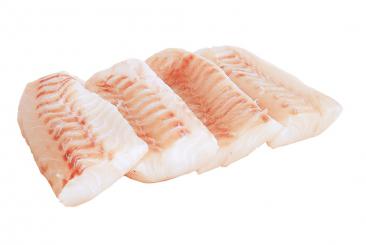 Read More
Read MoreThe Atlantic cod (Gadus morhua) is a benthopelagic fish of the family Gadidae, widely consumed by humans. It is also commercially known as cod or codling. Dry cod may be prepared as unsalted stockfish or as cured salt cod or clipfish.
In the western Atlantic Ocean, cod has a distribution north of Cape Hatteras, North Carolina, and around both coasts of Greenland and the Labrador Sea; in the eastern Atlantic, it is found from the Bay of Biscay north to the Arctic Ocean, including the Baltic Sea, the North Sea, Sea of the Hebrides,[13] areas around Iceland and the Barents Sea.
It can grow to 2 m (6 ft 7 in) in length and weigh up to 96 kg (212 lb). It can live for 25 years and usually attains sexual maturity between ages two and four, but cod in the northeast Arctic can take as long as eight years to fully mature.Colouring is brown to green, with spots on the dorsal side, shading to silver ventrally. A stripe along its lateral line is clearly visible. Its habitat ranges from the shoreline down to the continental shelf.
Several cod stocks collapsed in the 1990s (declined by >95% of maximum historical biomass) and have failed to recover even with the cessation of fishing.This absence of the apex predator has led to a trophic cascade in many areas.[16] Many other cod stocks remain at risk. The Atlantic cod is labelled vulnerable on the IUCN Red List of Threatened Species. -
Atlantic Cod
Read MoreThe Atlantic cod (Gadus morhua) is a benthopelagic fish of the family Gadidae, widely consumed by humans. It is also commercially known as cod or codling. Dry cod may be prepared as unsalted stockfish or as cured salt cod or clipfish.
In the western Atlantic Ocean, cod has a distribution north of Cape Hatteras, North Carolina, and around both coasts of Greenland and the Labrador Sea; in the eastern Atlantic, it is found from the Bay of Biscay north to the Arctic Ocean, including the Baltic Sea, the North Sea, Sea of the Hebrides,[13] areas around Iceland and the Barents Sea.
It can grow to 2 m (6 ft 7 in) in length and weigh up to 96 kg (212 lb). It can live for 25 years and usually attains sexual maturity between ages two and four, but cod in the northeast Arctic can take as long as eight years to fully mature.Colouring is brown to green, with spots on the dorsal side, shading to silver ventrally. A stripe along its lateral line is clearly visible. Its habitat ranges from the shoreline down to the continental shelf.
Several cod stocks collapsed in the 1990s (declined by >95% of maximum historical biomass) and have failed to recover even with the cessation of fishing.This absence of the apex predator has led to a trophic cascade in many areas.[16] Many other cod stocks remain at risk. The Atlantic cod is labelled vulnerable on the IUCN Red List of Threatened Species. -
Atlantic Cod loin without skin 800+
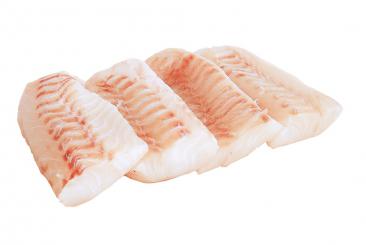 Read More
Read MoreThe Atlantic cod (Gadus morhua) is a benthopelagic fish of the family Gadidae, widely consumed by humans. It is also commercially known as cod or codling. Dry cod may be prepared as unsalted stockfish or as cured salt cod or clipfish.
In the western Atlantic Ocean, cod has a distribution north of Cape Hatteras, North Carolina, and around both coasts of Greenland and the Labrador Sea; in the eastern Atlantic, it is found from the Bay of Biscay north to the Arctic Ocean, including the Baltic Sea, the North Sea, Sea of the Hebrides,[13] areas around Iceland and the Barents Sea.
It can grow to 2 m (6 ft 7 in) in length and weigh up to 96 kg (212 lb). It can live for 25 years and usually attains sexual maturity between ages two and four, but cod in the northeast Arctic can take as long as eight years to fully mature.Colouring is brown to green, with spots on the dorsal side, shading to silver ventrally. A stripe along its lateral line is clearly visible. Its habitat ranges from the shoreline down to the continental shelf.
Several cod stocks collapsed in the 1990s (declined by >95% of maximum historical biomass) and have failed to recover even with the cessation of fishing.This absence of the apex predator has led to a trophic cascade in many areas.[16] Many other cod stocks remain at risk. The Atlantic cod is labelled vulnerable on the IUCN Red List of Threatened Species. -
Atlantic Cod loin with skin 1000+
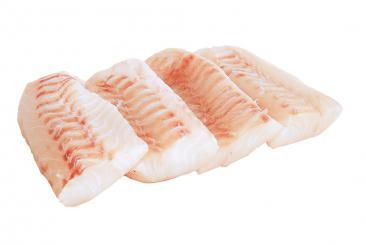 Read More
Read MoreThe Atlantic cod (Gadus morhua) is a benthopelagic fish of the family Gadidae, widely consumed by humans. It is also commercially known as cod or codling. Dry cod may be prepared as unsalted stockfish or as cured salt cod or clipfish.
In the western Atlantic Ocean, cod has a distribution north of Cape Hatteras, North Carolina, and around both coasts of Greenland and the Labrador Sea; in the eastern Atlantic, it is found from the Bay of Biscay north to the Arctic Ocean, including the Baltic Sea, the North Sea, Sea of the Hebrides,[13] areas around Iceland and the Barents Sea.
It can grow to 2 m (6 ft 7 in) in length and weigh up to 96 kg (212 lb). It can live for 25 years and usually attains sexual maturity between ages two and four, but cod in the northeast Arctic can take as long as eight years to fully mature.Colouring is brown to green, with spots on the dorsal side, shading to silver ventrally. A stripe along its lateral line is clearly visible. Its habitat ranges from the shoreline down to the continental shelf.
Several cod stocks collapsed in the 1990s (declined by >95% of maximum historical biomass) and have failed to recover even with the cessation of fishing.This absence of the apex predator has led to a trophic cascade in many areas.[16] Many other cod stocks remain at risk. The Atlantic cod is labelled vulnerable on the IUCN Red List of Threatened Species. -
Atlantic Cod loin with skin 800+
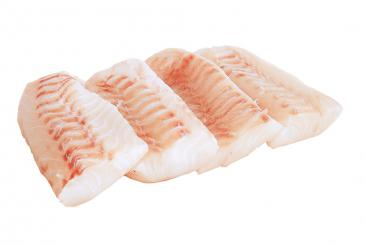 Read More
Read MoreThe Atlantic cod (Gadus morhua) is a benthopelagic fish of the family Gadidae, widely consumed by humans. It is also commercially known as cod or codling. Dry cod may be prepared as unsalted stockfish or as cured salt cod or clipfish.
In the western Atlantic Ocean, cod has a distribution north of Cape Hatteras, North Carolina, and around both coasts of Greenland and the Labrador Sea; in the eastern Atlantic, it is found from the Bay of Biscay north to the Arctic Ocean, including the Baltic Sea, the North Sea, Sea of the Hebrides,[13] areas around Iceland and the Barents Sea.
It can grow to 2 m (6 ft 7 in) in length and weigh up to 96 kg (212 lb). It can live for 25 years and usually attains sexual maturity between ages two and four, but cod in the northeast Arctic can take as long as eight years to fully mature.Colouring is brown to green, with spots on the dorsal side, shading to silver ventrally. A stripe along its lateral line is clearly visible. Its habitat ranges from the shoreline down to the continental shelf.
Several cod stocks collapsed in the 1990s (declined by >95% of maximum historical biomass) and have failed to recover even with the cessation of fishing.This absence of the apex predator has led to a trophic cascade in many areas.[16] Many other cod stocks remain at risk. The Atlantic cod is labelled vulnerable on the IUCN Red List of Threatened Species. -
Baltic Cod fillet without skin
Read MoreCod is popular as a food with a mild flavour and a dense, flaky, white flesh. Cod livers are processed to make cod liver oil, an important source of vitamin A, vitamin D, vitamin E, and omega-3 fatty acids (EPA and DHA). Young Atlantic cod or haddock prepared in strips for cooking is called scrod. In the United Kingdom, Atlantic cod is one of the most common ingredients in fish and chips, along with haddock and plaice.
-
Baltic Cod gutted
Read MoreCod is popular as a food with a mild flavour and a dense, flaky, white flesh. Cod livers are processed to make cod liver oil, an important source of vitamin A, vitamin D, vitamin E, and omega-3 fatty acids (EPA and DHA). Young Atlantic cod or haddock prepared in strips for cooking is called scrod. In the United Kingdom, Atlantic cod is one of the most common ingredients in fish and chips, along with haddock and plaice.
-
Baltic Cod fillet with skin
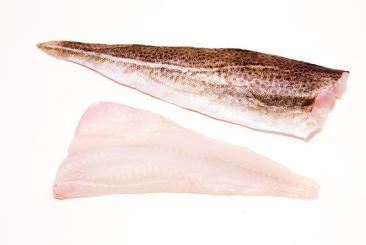 Read More
Read MoreCod is popular as a food with a mild flavour and a dense, flaky, white flesh. Cod livers are processed to make cod liver oil, an important source of vitamin A, vitamin D, vitamin E, and omega-3 fatty acids (EPA and DHA). Young Atlantic cod or haddock prepared in strips for cooking is called scrod. In the United Kingdom, Atlantic cod is one of the most common ingredients in fish and chips, along with haddock and plaice.
-
Atlantic Cod loins with skin
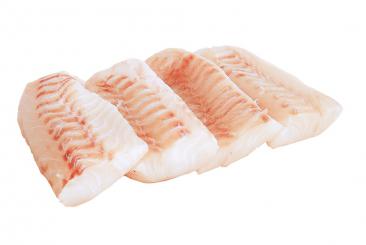 Read More
Read MoreThe Atlantic cod (Gadus morhua) is a benthopelagic fish of the family Gadidae, widely consumed by humans. It is also commercially known as cod or codling. Dry cod may be prepared as unsalted stockfish or as cured salt cod or clipfish.
In the western Atlantic Ocean, cod has a distribution north of Cape Hatteras, North Carolina, and around both coasts of Greenland and the Labrador Sea; in the eastern Atlantic, it is found from the Bay of Biscay north to the Arctic Ocean, including the Baltic Sea, the North Sea, Sea of the Hebrides,[13] areas around Iceland and the Barents Sea.
It can grow to 2 m (6 ft 7 in) in length and weigh up to 96 kg (212 lb). It can live for 25 years and usually attains sexual maturity between ages two and four, but cod in the northeast Arctic can take as long as eight years to fully mature.Colouring is brown to green, with spots on the dorsal side, shading to silver ventrally. A stripe along its lateral line is clearly visible. Its habitat ranges from the shoreline down to the continental shelf.
Several cod stocks collapsed in the 1990s (declined by >95% of maximum historical biomass) and have failed to recover even with the cessation of fishing.This absence of the apex predator has led to a trophic cascade in many areas.[16] Many other cod stocks remain at risk. The Atlantic cod is labelled vulnerable on the IUCN Red List of Threatened Species. -
European Flounder
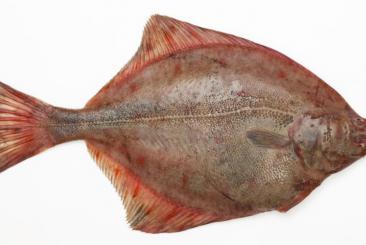 Read More
Read MoreThe European flounder (Platichthys flesus) is a flatfish of European coastal waters from the White Sea in the north to the Mediterranean and the Black Sea in the south. It has been introduced into the United States and Canada accidentally through transport in ballast water. It is caught and used for human consumption.
The European flounder is oval in shape and is usually right-eyed. It normally grows about 30 cm in length, although lengths of up to 60 cm have been recorded. The upper surface is usually dull brown or olive in colour with reddish spots and brown blotches and this fish can change colour to suit its background, providing an effective camouflage. The underside is pearly-white, giving the fish one of its common names, the white fluke. The lateral line features rows of small tubercles, as do the bases of the dorsal and anal fins. -
European Flounder without head
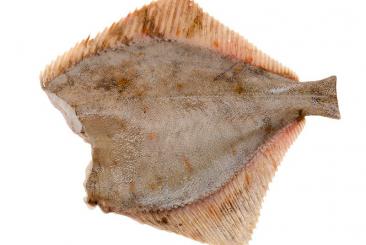 Read More
Read MoreThe European flounder (Platichthys flesus) is a flatfish of European coastal waters from the White Sea in the north to the Mediterranean and the Black Sea in the south. It has been introduced into the United States and Canada accidentally through transport in ballast water. It is caught and used for human consumption.
The European flounder is oval in shape and is usually right-eyed. It normally grows about 30 cm in length, although lengths of up to 60 cm have been recorded. The upper surface is usually dull brown or olive in colour with reddish spots and brown blotches and this fish can change colour to suit its background, providing an effective camouflage. The underside is pearly-white, giving the fish one of its common names, the white fluke. The lateral line features rows of small tubercles, as do the bases of the dorsal and anal fins. -
Atlantic halibut filet without skin
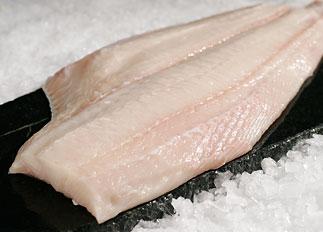 Read More
Read MoreThe Atlantic halibut (Hippoglossus hippoglossus) is a flatfish of the family Pleuronectidae. They are demersal fish living on or near sand, gravel or clay bottoms at depths of between 50 and 2,000 m (160 and 6,560 ft). The halibut is among the largest teleost (bony) fish in the world, and is an endangered species due to a slow rate of growth and previous overfishing.Halibut are strong swimmers and are able to migrate long distances. Halibut size is not age-specific, but rather tends to follow a cycle related to halibut (and therefore food) abundance.
The native habitat of the Atlantic halibut is the temperate and arctic waters of the northern Atlantic, from Labrador and Greenland to Iceland, the Barents Sea and as far south as the Bay of Biscay and Virginia. It is the largest flatfish in the world, reaching lengths of up to 4.7 m (15 ft) and weights of 320 kg (710 lb). Its lifespan can reach 50 years. -
Atlantic halibut filet with skin
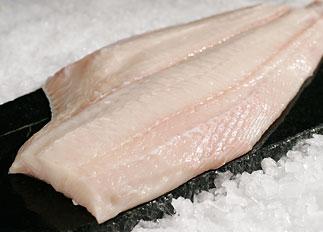 Read More
Read MoreThe Atlantic halibut (Hippoglossus hippoglossus) is a flatfish of the family Pleuronectidae. They are demersal fish living on or near sand, gravel or clay bottoms at depths of between 50 and 2,000 m (160 and 6,560 ft). The halibut is among the largest teleost (bony) fish in the world, and is an endangered species due to a slow rate of growth and previous overfishing.Halibut are strong swimmers and are able to migrate long distances. Halibut size is not age-specific, but rather tends to follow a cycle related to halibut (and therefore food) abundance.
The native habitat of the Atlantic halibut is the temperate and arctic waters of the northern Atlantic, from Labrador and Greenland to Iceland, the Barents Sea and as far south as the Bay of Biscay and Virginia. It is the largest flatfish in the world, reaching lengths of up to 4.7 m (15 ft) and weights of 320 kg (710 lb). Its lifespan can reach 50 years. -
Meagre wole 1000/2000
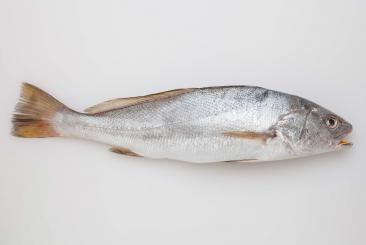 Read More
Read MoreArgyrosomus regius (also known as meagre, shade-fish, corvina, salmon-basse or stone basse) is a fish of the family Sciaenidae. It has a similar form to a European seabass, with a pearly-silver coloration and a yellow-coloured mouth. Length can range from 40–50 cm to 2 m long, with weights up to 55 kg.
A. regius is a carnivore found in pelagic coastal areas. Its depth distribution ranges from 15 to 300 m. Distribution include the Atlantic Ocean (from France to Senegal) and the Mediterranean Sea, with some records of its presence in the northern Red Sea. -
Meagre wole gutted 3+
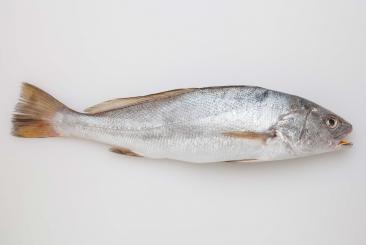 Read More
Read MoreArgyrosomus regius (also known as meagre, shade-fish, corvina, salmon-basse or stone basse) is a fish of the family Sciaenidae. It has a similar form to a European seabass, with a pearly-silver coloration and a yellow-coloured mouth. Length can range from 40–50 cm to 2 m long, with weights up to 55 kg.
A. regius is a carnivore found in pelagic coastal areas. Its depth distribution ranges from 15 to 300 m. Distribution include the Atlantic Ocean (from France to Senegal) and the Mediterranean Sea, with some records of its presence in the northern Red Sea. -
Red gurnard
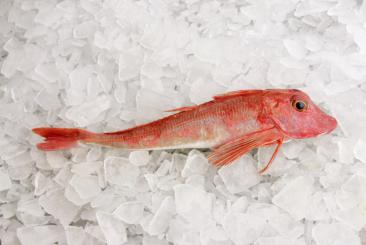 Read More
Read MoreThe Red gurnard, also East Atlantic red gurnard (Chelidonichthys cuculus) is a fish species of Triglidae family. Widespread in the Eastern Atlantic from British Isles (occasionally Norway) to Mauritania (including Madeira and Azores). Also known throughout the Mediterranean and possibly in the Black Sea. he red gurnard is native to the temperate eastern Atlantic Ocean and the Mediterranean Sea. Its range extends from southern Norway and Sweden southwards to the British Isles, France, Spain, Madeira, the Azores and the coast of Africa as far south as Mauritania. It is also present in the Mediterranean Sea and possibly the Black Sea. Its depth range is from the surface down to about 400 m (1,312 ft) but it is most usually found between 30 and 250 m (98 and 820 ft). It is found over sand, shingle or rocky seabeds and feeds on bottom-dwelling invertebrates, such as crustaceans, and also small fish.
-
Sea bass gutted 300/400
Read MoreThe seabass (Dicentrarchus labrax) is a primarily ocean-going fish that sometimes enters brackish and fresh waters. It is also known as the sea dace. Highly regarded as a table fish, it is often marketed as Mediterranean seabass, loup de mer, robalo, lubina, spigola, branzino, or bronzino. Annual catches of wild European seabass are relatively modest, having fluctuated between 8,500 and 11,900 tonnes in 2000–2009. Most of the reported catches originate from the Atlantic Ocean, with France typically reporting the highest catches. In the Mediterranean, Italy used to report the largest catches, but has been surpassed by Egypt in recent years.
The fish has come under increasing pressure from commercial fishing and has recently become the focus in the United Kingdom of a conservation effort by recreational anglers.The Republic of Ireland has strict laws regarding bass. All commercial fishing for the species is banned and several restrictions are in place for recreational anglers, a closed season May 15 – June 15 inclusive every year, a minimum size of 400 mm, and a bag limit of two fish per day. In a scientific advice (June 2013), it is stressed that fishing mortality is increasing. The total biomass has been declining since 2005. Total biomass, assumed as the best stock size indicator in the last two years (2011–2012), was 32% lower than the total biomass in the three previous years (2008–2010). European seabass was one of the first types of fish to be farmed commercially in Europe. They were historically cultured in coastal lagoons and tidal reservoirs, before mass-production techniques were developed starting in the late 1960s. It is the most important commercial fish widely cultured in the Mediterranean. The most important farming countries are Greece, Turkey, Italy, Spain, Croatia, and Egypt. Annual production was more than 120,000 tonnes in 2010. -
Sea bass whole 300/400
Read MoreThe seabass (Dicentrarchus labrax) is a primarily ocean-going fish that sometimes enters brackish and fresh waters. It is also known as the sea dace. Highly regarded as a table fish, it is often marketed as Mediterranean seabass, loup de mer, robalo, lubina, spigola, branzino, or bronzino. Annual catches of wild European seabass are relatively modest, having fluctuated between 8,500 and 11,900 tonnes in 2000–2009. Most of the reported catches originate from the Atlantic Ocean, with France typically reporting the highest catches. In the Mediterranean, Italy used to report the largest catches, but has been surpassed by Egypt in recent years.
The fish has come under increasing pressure from commercial fishing and has recently become the focus in the United Kingdom of a conservation effort by recreational anglers.The Republic of Ireland has strict laws regarding bass. All commercial fishing for the species is banned and several restrictions are in place for recreational anglers, a closed season May 15 – June 15 inclusive every year, a minimum size of 400 mm, and a bag limit of two fish per day. In a scientific advice (June 2013), it is stressed that fishing mortality is increasing. The total biomass has been declining since 2005. Total biomass, assumed as the best stock size indicator in the last two years (2011–2012), was 32% lower than the total biomass in the three previous years (2008–2010). European seabass was one of the first types of fish to be farmed commercially in Europe. They were historically cultured in coastal lagoons and tidal reservoirs, before mass-production techniques were developed starting in the late 1960s. It is the most important commercial fish widely cultured in the Mediterranean. The most important farming countries are Greece, Turkey, Italy, Spain, Croatia, and Egypt. Annual production was more than 120,000 tonnes in 2010. -
Sea bass whole 400/600
Read MoreThe seabass (Dicentrarchus labrax) is a primarily ocean-going fish that sometimes enters brackish and fresh waters. It is also known as the sea dace. Highly regarded as a table fish, it is often marketed as Mediterranean seabass, loup de mer, robalo, lubina, spigola, branzino, or bronzino. Annual catches of wild European seabass are relatively modest, having fluctuated between 8,500 and 11,900 tonnes in 2000–2009. Most of the reported catches originate from the Atlantic Ocean, with France typically reporting the highest catches. In the Mediterranean, Italy used to report the largest catches, but has been surpassed by Egypt in recent years.
The fish has come under increasing pressure from commercial fishing and has recently become the focus in the United Kingdom of a conservation effort by recreational anglers.The Republic of Ireland has strict laws regarding bass. All commercial fishing for the species is banned and several restrictions are in place for recreational anglers, a closed season May 15 – June 15 inclusive every year, a minimum size of 400 mm, and a bag limit of two fish per day. In a scientific advice (June 2013), it is stressed that fishing mortality is increasing. The total biomass has been declining since 2005. Total biomass, assumed as the best stock size indicator in the last two years (2011–2012), was 32% lower than the total biomass in the three previous years (2008–2010). European seabass was one of the first types of fish to be farmed commercially in Europe. They were historically cultured in coastal lagoons and tidal reservoirs, before mass-production techniques were developed starting in the late 1960s. It is the most important commercial fish widely cultured in the Mediterranean. The most important farming countries are Greece, Turkey, Italy, Spain, Croatia, and Egypt. Annual production was more than 120,000 tonnes in 2010. -
Sea bass whole 600/800
Read MoreThe seabass (Dicentrarchus labrax) is a primarily ocean-going fish that sometimes enters brackish and fresh waters. It is also known as the sea dace. Highly regarded as a table fish, it is often marketed as Mediterranean seabass, loup de mer, robalo, lubina, spigola, branzino, or bronzino. Annual catches of wild European seabass are relatively modest, having fluctuated between 8,500 and 11,900 tonnes in 2000–2009. Most of the reported catches originate from the Atlantic Ocean, with France typically reporting the highest catches. In the Mediterranean, Italy used to report the largest catches, but has been surpassed by Egypt in recent years.
The fish has come under increasing pressure from commercial fishing and has recently become the focus in the United Kingdom of a conservation effort by recreational anglers.The Republic of Ireland has strict laws regarding bass. All commercial fishing for the species is banned and several restrictions are in place for recreational anglers, a closed season May 15 – June 15 inclusive every year, a minimum size of 400 mm, and a bag limit of two fish per day. In a scientific advice (June 2013), it is stressed that fishing mortality is increasing. The total biomass has been declining since 2005. Total biomass, assumed as the best stock size indicator in the last two years (2011–2012), was 32% lower than the total biomass in the three previous years (2008–2010). European seabass was one of the first types of fish to be farmed commercially in Europe. They were historically cultured in coastal lagoons and tidal reservoirs, before mass-production techniques were developed starting in the late 1960s. It is the most important commercial fish widely cultured in the Mediterranean. The most important farming countries are Greece, Turkey, Italy, Spain, Croatia, and Egypt. Annual production was more than 120,000 tonnes in 2010. -
Sea bass whole 800+
Read MoreThe seabass (Dicentrarchus labrax) is a primarily ocean-going fish that sometimes enters brackish and fresh waters. It is also known as the sea dace. Highly regarded as a table fish, it is often marketed as Mediterranean seabass, loup de mer, robalo, lubina, spigola, branzino, or bronzino. Annual catches of wild European seabass are relatively modest, having fluctuated between 8,500 and 11,900 tonnes in 2000–2009. Most of the reported catches originate from the Atlantic Ocean, with France typically reporting the highest catches. In the Mediterranean, Italy used to report the largest catches, but has been surpassed by Egypt in recent years.
The fish has come under increasing pressure from commercial fishing and has recently become the focus in the United Kingdom of a conservation effort by recreational anglers.The Republic of Ireland has strict laws regarding bass. All commercial fishing for the species is banned and several restrictions are in place for recreational anglers, a closed season May 15 – June 15 inclusive every year, a minimum size of 400 mm, and a bag limit of two fish per day. In a scientific advice (June 2013), it is stressed that fishing mortality is increasing. The total biomass has been declining since 2005. Total biomass, assumed as the best stock size indicator in the last two years (2011–2012), was 32% lower than the total biomass in the three previous years (2008–2010). European seabass was one of the first types of fish to be farmed commercially in Europe. They were historically cultured in coastal lagoons and tidal reservoirs, before mass-production techniques were developed starting in the late 1960s. It is the most important commercial fish widely cultured in the Mediterranean. The most important farming countries are Greece, Turkey, Italy, Spain, Croatia, and Egypt. Annual production was more than 120,000 tonnes in 2010. -
Sea bass fillet
Read MoreThe seabass (Dicentrarchus labrax) is a primarily ocean-going fish that sometimes enters brackish and fresh waters. It is also known as the sea dace. Highly regarded as a table fish, it is often marketed as Mediterranean seabass, loup de mer, robalo, lubina, spigola, branzino, or bronzino. Annual catches of wild European seabass are relatively modest, having fluctuated between 8,500 and 11,900 tonnes in 2000–2009. Most of the reported catches originate from the Atlantic Ocean, with France typically reporting the highest catches. In the Mediterranean, Italy used to report the largest catches, but has been surpassed by Egypt in recent years.
The fish has come under increasing pressure from commercial fishing and has recently become the focus in the United Kingdom of a conservation effort by recreational anglers.The Republic of Ireland has strict laws regarding bass. All commercial fishing for the species is banned and several restrictions are in place for recreational anglers, a closed season May 15 – June 15 inclusive every year, a minimum size of 400 mm, and a bag limit of two fish per day. In a scientific advice (June 2013), it is stressed that fishing mortality is increasing. The total biomass has been declining since 2005. Total biomass, assumed as the best stock size indicator in the last two years (2011–2012), was 32% lower than the total biomass in the three previous years (2008–2010). European seabass was one of the first types of fish to be farmed commercially in Europe. They were historically cultured in coastal lagoons and tidal reservoirs, before mass-production techniques were developed starting in the late 1960s. It is the most important commercial fish widely cultured in the Mediterranean. The most important farming countries are Greece, Turkey, Italy, Spain, Croatia, and Egypt. Annual production was more than 120,000 tonnes in 2010. -
Salmon whole 4000/5000
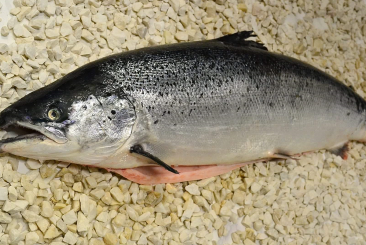 Read More
Read MoreSalmon is a popular food. Classified as an oily fish, salmon is considered to be healthy due to the fish's high protein, high omega-3 fatty acids, and high vitamin D content. Salmon is also a source of cholesterol, with a range of 23–214 mg/100 g depending on the species. According to reports in the journal Science, farmed salmon may contain high levels of dioxins.[medical citation needed] PCB (polychlorinated biphenyl) levels may be up to eight times higher in farmed salmon than in wild salmon, but still well below levels considered dangerous.[88][89] Nonetheless, according to a 2006 study published in the Journal of the American Medical Association, the benefits of eating even farmed salmon still outweigh any risks imposed by contaminants.[90] Farmed salmon has a high omega 3 fatty acid content comparable to wild salmon. The type of omega-3 present may not be a factor for other important health functions.
Salmon flesh is generally orange to red, although white-fleshed wild salmon with white-black skin colour occurs. The natural colour of salmon results from carotenoid pigments, largely astaxanthin, but also canthaxanthin, in the flesh. Wild salmon get these carotenoids from eating krill and other tiny shellfish.
The vast majority of Atlantic salmon available around the world are farmed (almost 99%), whereas the majority of Pacific salmon are wild-caught (greater than 80%). Canned salmon in the US is usually wild Pacific catch, though some farmed salmon is available in canned form. Smoked salmon is another popular preparation method, and can either be hot or cold smoked. Lox can refer to either cold-smoked salmon or salmon cured in a brine solution (also called gravlax). Traditional canned salmon includes some skin (which is harmless) and bone (which adds calcium). Skinless and boneless canned salmon is also available.
Raw salmon flesh may contain Anisakis nematodes, marine parasites that cause anisakiasis. Before the availability of refrigeration, the Japanese did not consume raw salmon. Salmon and salmon roe have only recently come into use in making sashimi (raw fish) and sushi.
To the Indigenous peoples of the Pacific Northwest Coast, salmon is considered a vital part of the diet. Specifically, the indigenous peoples of Haida Gwaii, located near former Queen Charlotte Island in British Columbia, rely on salmon as one of their main sources of food, although many other bands have fished Pacific waters for centuries. Salmon are not only ancient and unique, but it is important because it is expressed in culture, art forms, and ceremonial feasts. Annually, salmon spawn in Haida, feeding on everything on the way upstream and down. In Haida, salmon is referred to as "tsiin" There are many forms of preparing it including: smoking, baking, frying, making soup, or candied salmon
Historically, there has always been enough salmon, as people would not overfish, and only took what they needed. In 2003, a report on First Nation participation in commercial fisheries, including salmon, commissioned by BC’s Ministry of Agriculture, Food and Fisheries found that there were 595 First Nation-owned and operated commercial vessels in the province. Of those vessels, First Nations’ members owned 564. However, employment within the industry has decreased overall by 50% in the last decade, with 8,142 registered commercial fishermen in 2003. This has affected employment for many fisherman, who rely on salmon as a source of income.
Black bears also rely on salmon as food. The leftovers the bears leave behind are considered important nutrients for the forest, such as the soil, trees, and plants. In this sense, the salmon feed the forest and in return receive clean water and gravel in which to hatch and grow, sheltered from extremes of temperature and water flow in times of high and low rainfall. However, the condition of the salmon in Haida has been affected in recent decades. Due to logging and development, much of the salmon's habitat (i.e.: Ain River) has been destroyed, resulting in the fish being close to endangered. For residents, this has resulted in limits on catches, in turn, has affected families diets, and cultural events such as feasts. Some of the salmon systems in danger include: the Davidon, Naden, Mamim, and Mathers. It is clear that further protection is needed for salmon, such as their habitats, where logging commonly occurs. -
Salmon whole 5000/6000
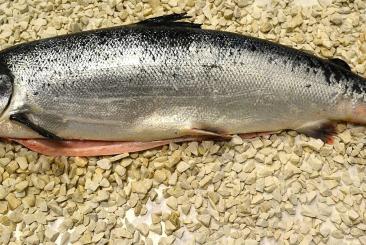 Read More
Read MoreSalmon is a popular food. Classified as an oily fish, salmon is considered to be healthy due to the fish's high protein, high omega-3 fatty acids, and high vitamin D content. Salmon is also a source of cholesterol, with a range of 23–214 mg/100 g depending on the species. According to reports in the journal Science, farmed salmon may contain high levels of dioxins.[medical citation needed] PCB (polychlorinated biphenyl) levels may be up to eight times higher in farmed salmon than in wild salmon, but still well below levels considered dangerous.[88][89] Nonetheless, according to a 2006 study published in the Journal of the American Medical Association, the benefits of eating even farmed salmon still outweigh any risks imposed by contaminants.[90] Farmed salmon has a high omega 3 fatty acid content comparable to wild salmon. The type of omega-3 present may not be a factor for other important health functions.
Salmon flesh is generally orange to red, although white-fleshed wild salmon with white-black skin colour occurs. The natural colour of salmon results from carotenoid pigments, largely astaxanthin, but also canthaxanthin, in the flesh. Wild salmon get these carotenoids from eating krill and other tiny shellfish.
The vast majority of Atlantic salmon available around the world are farmed (almost 99%), whereas the majority of Pacific salmon are wild-caught (greater than 80%). Canned salmon in the US is usually wild Pacific catch, though some farmed salmon is available in canned form. Smoked salmon is another popular preparation method, and can either be hot or cold smoked. Lox can refer to either cold-smoked salmon or salmon cured in a brine solution (also called gravlax). Traditional canned salmon includes some skin (which is harmless) and bone (which adds calcium). Skinless and boneless canned salmon is also available.
Raw salmon flesh may contain Anisakis nematodes, marine parasites that cause anisakiasis. Before the availability of refrigeration, the Japanese did not consume raw salmon. Salmon and salmon roe have only recently come into use in making sashimi (raw fish) and sushi.
To the Indigenous peoples of the Pacific Northwest Coast, salmon is considered a vital part of the diet. Specifically, the indigenous peoples of Haida Gwaii, located near former Queen Charlotte Island in British Columbia, rely on salmon as one of their main sources of food, although many other bands have fished Pacific waters for centuries. Salmon are not only ancient and unique, but it is important because it is expressed in culture, art forms, and ceremonial feasts. Annually, salmon spawn in Haida, feeding on everything on the way upstream and down. In Haida, salmon is referred to as "tsiin" There are many forms of preparing it including: smoking, baking, frying, making soup, or candied salmon
Historically, there has always been enough salmon, as people would not overfish, and only took what they needed. In 2003, a report on First Nation participation in commercial fisheries, including salmon, commissioned by BC’s Ministry of Agriculture, Food and Fisheries found that there were 595 First Nation-owned and operated commercial vessels in the province. Of those vessels, First Nations’ members owned 564. However, employment within the industry has decreased overall by 50% in the last decade, with 8,142 registered commercial fishermen in 2003. This has affected employment for many fisherman, who rely on salmon as a source of income.
Black bears also rely on salmon as food. The leftovers the bears leave behind are considered important nutrients for the forest, such as the soil, trees, and plants. In this sense, the salmon feed the forest and in return receive clean water and gravel in which to hatch and grow, sheltered from extremes of temperature and water flow in times of high and low rainfall. However, the condition of the salmon in Haida has been affected in recent decades. Due to logging and development, much of the salmon's habitat (i.e.: Ain River) has been destroyed, resulting in the fish being close to endangered. For residents, this has resulted in limits on catches, in turn, has affected families diets, and cultural events such as feasts. Some of the salmon systems in danger include: the Davidon, Naden, Mamim, and Mathers. It is clear that further protection is needed for salmon, such as their habitats, where logging commonly occurs. -
Salmon whole 6000/7000
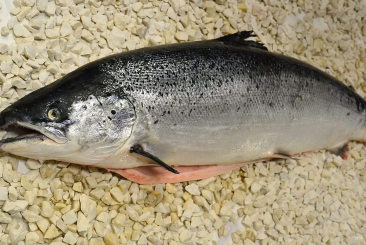 Read More
Read MoreSalmon is a popular food. Classified as an oily fish, salmon is considered to be healthy due to the fish's high protein, high omega-3 fatty acids, and high vitamin D content. Salmon is also a source of cholesterol, with a range of 23–214 mg/100 g depending on the species. According to reports in the journal Science, farmed salmon may contain high levels of dioxins.[medical citation needed] PCB (polychlorinated biphenyl) levels may be up to eight times higher in farmed salmon than in wild salmon, but still well below levels considered dangerous.[88][89] Nonetheless, according to a 2006 study published in the Journal of the American Medical Association, the benefits of eating even farmed salmon still outweigh any risks imposed by contaminants.[90] Farmed salmon has a high omega 3 fatty acid content comparable to wild salmon. The type of omega-3 present may not be a factor for other important health functions.
Salmon flesh is generally orange to red, although white-fleshed wild salmon with white-black skin colour occurs. The natural colour of salmon results from carotenoid pigments, largely astaxanthin, but also canthaxanthin, in the flesh. Wild salmon get these carotenoids from eating krill and other tiny shellfish.
The vast majority of Atlantic salmon available around the world are farmed (almost 99%), whereas the majority of Pacific salmon are wild-caught (greater than 80%). Canned salmon in the US is usually wild Pacific catch, though some farmed salmon is available in canned form. Smoked salmon is another popular preparation method, and can either be hot or cold smoked. Lox can refer to either cold-smoked salmon or salmon cured in a brine solution (also called gravlax). Traditional canned salmon includes some skin (which is harmless) and bone (which adds calcium). Skinless and boneless canned salmon is also available.
Raw salmon flesh may contain Anisakis nematodes, marine parasites that cause anisakiasis. Before the availability of refrigeration, the Japanese did not consume raw salmon. Salmon and salmon roe have only recently come into use in making sashimi (raw fish) and sushi.
To the Indigenous peoples of the Pacific Northwest Coast, salmon is considered a vital part of the diet. Specifically, the indigenous peoples of Haida Gwaii, located near former Queen Charlotte Island in British Columbia, rely on salmon as one of their main sources of food, although many other bands have fished Pacific waters for centuries. Salmon are not only ancient and unique, but it is important because it is expressed in culture, art forms, and ceremonial feasts. Annually, salmon spawn in Haida, feeding on everything on the way upstream and down. In Haida, salmon is referred to as "tsiin" There are many forms of preparing it including: smoking, baking, frying, making soup, or candied salmon
Historically, there has always been enough salmon, as people would not overfish, and only took what they needed. In 2003, a report on First Nation participation in commercial fisheries, including salmon, commissioned by BC’s Ministry of Agriculture, Food and Fisheries found that there were 595 First Nation-owned and operated commercial vessels in the province. Of those vessels, First Nations’ members owned 564. However, employment within the industry has decreased overall by 50% in the last decade, with 8,142 registered commercial fishermen in 2003. This has affected employment for many fisherman, who rely on salmon as a source of income.
Black bears also rely on salmon as food. The leftovers the bears leave behind are considered important nutrients for the forest, such as the soil, trees, and plants. In this sense, the salmon feed the forest and in return receive clean water and gravel in which to hatch and grow, sheltered from extremes of temperature and water flow in times of high and low rainfall. However, the condition of the salmon in Haida has been affected in recent decades. Due to logging and development, much of the salmon's habitat (i.e.: Ain River) has been destroyed, resulting in the fish being close to endangered. For residents, this has resulted in limits on catches, in turn, has affected families diets, and cultural events such as feasts. Some of the salmon systems in danger include: the Davidon, Naden, Mamim, and Mathers. It is clear that further protection is needed for salmon, such as their habitats, where logging commonly occurs. -
Salmon fillet skinless 4000/5000 trim E
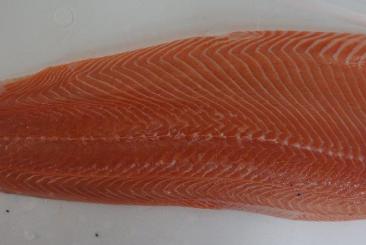 Read More
Read MoreSalmon is a popular food. Classified as an oily fish, salmon is considered to be healthy due to the fish's high protein, high omega-3 fatty acids, and high vitamin D content. Salmon is also a source of cholesterol, with a range of 23–214 mg/100 g depending on the species. According to reports in the journal Science, farmed salmon may contain high levels of dioxins.[medical citation needed] PCB (polychlorinated biphenyl) levels may be up to eight times higher in farmed salmon than in wild salmon, but still well below levels considered dangerous.[88][89] Nonetheless, according to a 2006 study published in the Journal of the American Medical Association, the benefits of eating even farmed salmon still outweigh any risks imposed by contaminants.[90] Farmed salmon has a high omega 3 fatty acid content comparable to wild salmon. The type of omega-3 present may not be a factor for other important health functions.
Salmon flesh is generally orange to red, although white-fleshed wild salmon with white-black skin colour occurs. The natural colour of salmon results from carotenoid pigments, largely astaxanthin, but also canthaxanthin, in the flesh. Wild salmon get these carotenoids from eating krill and other tiny shellfish.
The vast majority of Atlantic salmon available around the world are farmed (almost 99%), whereas the majority of Pacific salmon are wild-caught (greater than 80%). Canned salmon in the US is usually wild Pacific catch, though some farmed salmon is available in canned form. Smoked salmon is another popular preparation method, and can either be hot or cold smoked. Lox can refer to either cold-smoked salmon or salmon cured in a brine solution (also called gravlax). Traditional canned salmon includes some skin (which is harmless) and bone (which adds calcium). Skinless and boneless canned salmon is also available.
Raw salmon flesh may contain Anisakis nematodes, marine parasites that cause anisakiasis. Before the availability of refrigeration, the Japanese did not consume raw salmon. Salmon and salmon roe have only recently come into use in making sashimi (raw fish) and sushi.
To the Indigenous peoples of the Pacific Northwest Coast, salmon is considered a vital part of the diet. Specifically, the indigenous peoples of Haida Gwaii, located near former Queen Charlotte Island in British Columbia, rely on salmon as one of their main sources of food, although many other bands have fished Pacific waters for centuries. Salmon are not only ancient and unique, but it is important because it is expressed in culture, art forms, and ceremonial feasts. Annually, salmon spawn in Haida, feeding on everything on the way upstream and down. In Haida, salmon is referred to as "tsiin" There are many forms of preparing it including: smoking, baking, frying, making soup, or candied salmon
Historically, there has always been enough salmon, as people would not overfish, and only took what they needed. In 2003, a report on First Nation participation in commercial fisheries, including salmon, commissioned by BC’s Ministry of Agriculture, Food and Fisheries found that there were 595 First Nation-owned and operated commercial vessels in the province. Of those vessels, First Nations’ members owned 564. However, employment within the industry has decreased overall by 50% in the last decade, with 8,142 registered commercial fishermen in 2003. This has affected employment for many fisherman, who rely on salmon as a source of income.
Black bears also rely on salmon as food. The leftovers the bears leave behind are considered important nutrients for the forest, such as the soil, trees, and plants. In this sense, the salmon feed the forest and in return receive clean water and gravel in which to hatch and grow, sheltered from extremes of temperature and water flow in times of high and low rainfall. However, the condition of the salmon in Haida has been affected in recent decades. Due to logging and development, much of the salmon's habitat (i.e.: Ain River) has been destroyed, resulting in the fish being close to endangered. For residents, this has resulted in limits on catches, in turn, has affected families diets, and cultural events such as feasts. Some of the salmon systems in danger include: the Davidon, Naden, Mamim, and Mathers. It is clear that further protection is needed for salmon, such as their habitats, where logging commonly occurs. -
Salmon fillet skinless 5000/6000 trim E
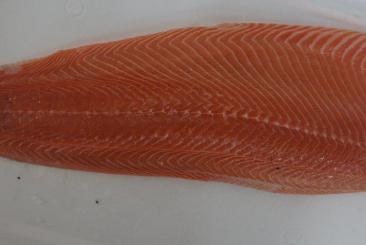 Read More
Read MoreSalmon is a popular food. Classified as an oily fish, salmon is considered to be healthy due to the fish's high protein, high omega-3 fatty acids, and high vitamin D content. Salmon is also a source of cholesterol, with a range of 23–214 mg/100 g depending on the species. According to reports in the journal Science, farmed salmon may contain high levels of dioxins.[medical citation needed] PCB (polychlorinated biphenyl) levels may be up to eight times higher in farmed salmon than in wild salmon, but still well below levels considered dangerous.[88][89] Nonetheless, according to a 2006 study published in the Journal of the American Medical Association, the benefits of eating even farmed salmon still outweigh any risks imposed by contaminants.[90] Farmed salmon has a high omega 3 fatty acid content comparable to wild salmon. The type of omega-3 present may not be a factor for other important health functions.
Salmon flesh is generally orange to red, although white-fleshed wild salmon with white-black skin colour occurs. The natural colour of salmon results from carotenoid pigments, largely astaxanthin, but also canthaxanthin, in the flesh. Wild salmon get these carotenoids from eating krill and other tiny shellfish.
The vast majority of Atlantic salmon available around the world are farmed (almost 99%), whereas the majority of Pacific salmon are wild-caught (greater than 80%). Canned salmon in the US is usually wild Pacific catch, though some farmed salmon is available in canned form. Smoked salmon is another popular preparation method, and can either be hot or cold smoked. Lox can refer to either cold-smoked salmon or salmon cured in a brine solution (also called gravlax). Traditional canned salmon includes some skin (which is harmless) and bone (which adds calcium). Skinless and boneless canned salmon is also available.
Raw salmon flesh may contain Anisakis nematodes, marine parasites that cause anisakiasis. Before the availability of refrigeration, the Japanese did not consume raw salmon. Salmon and salmon roe have only recently come into use in making sashimi (raw fish) and sushi.
To the Indigenous peoples of the Pacific Northwest Coast, salmon is considered a vital part of the diet. Specifically, the indigenous peoples of Haida Gwaii, located near former Queen Charlotte Island in British Columbia, rely on salmon as one of their main sources of food, although many other bands have fished Pacific waters for centuries. Salmon are not only ancient and unique, but it is important because it is expressed in culture, art forms, and ceremonial feasts. Annually, salmon spawn in Haida, feeding on everything on the way upstream and down. In Haida, salmon is referred to as "tsiin" There are many forms of preparing it including: smoking, baking, frying, making soup, or candied salmon
Historically, there has always been enough salmon, as people would not overfish, and only took what they needed. In 2003, a report on First Nation participation in commercial fisheries, including salmon, commissioned by BC’s Ministry of Agriculture, Food and Fisheries found that there were 595 First Nation-owned and operated commercial vessels in the province. Of those vessels, First Nations’ members owned 564. However, employment within the industry has decreased overall by 50% in the last decade, with 8,142 registered commercial fishermen in 2003. This has affected employment for many fisherman, who rely on salmon as a source of income.
Black bears also rely on salmon as food. The leftovers the bears leave behind are considered important nutrients for the forest, such as the soil, trees, and plants. In this sense, the salmon feed the forest and in return receive clean water and gravel in which to hatch and grow, sheltered from extremes of temperature and water flow in times of high and low rainfall. However, the condition of the salmon in Haida has been affected in recent decades. Due to logging and development, much of the salmon's habitat (i.e.: Ain River) has been destroyed, resulting in the fish being close to endangered. For residents, this has resulted in limits on catches, in turn, has affected families diets, and cultural events such as feasts. Some of the salmon systems in danger include: the Davidon, Naden, Mamim, and Mathers. It is clear that further protection is needed for salmon, such as their habitats, where logging commonly occurs. -
Salmon fillet skinless 4000/5000 trim D
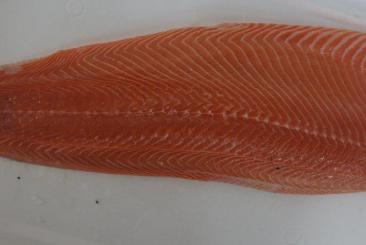 Read More
Read MoreSalmon is a popular food. Classified as an oily fish, salmon is considered to be healthy due to the fish's high protein, high omega-3 fatty acids, and high vitamin D content. Salmon is also a source of cholesterol, with a range of 23–214 mg/100 g depending on the species. According to reports in the journal Science, farmed salmon may contain high levels of dioxins.[medical citation needed] PCB (polychlorinated biphenyl) levels may be up to eight times higher in farmed salmon than in wild salmon, but still well below levels considered dangerous.[88][89] Nonetheless, according to a 2006 study published in the Journal of the American Medical Association, the benefits of eating even farmed salmon still outweigh any risks imposed by contaminants.[90] Farmed salmon has a high omega 3 fatty acid content comparable to wild salmon. The type of omega-3 present may not be a factor for other important health functions.
Salmon flesh is generally orange to red, although white-fleshed wild salmon with white-black skin colour occurs. The natural colour of salmon results from carotenoid pigments, largely astaxanthin, but also canthaxanthin, in the flesh. Wild salmon get these carotenoids from eating krill and other tiny shellfish.
The vast majority of Atlantic salmon available around the world are farmed (almost 99%), whereas the majority of Pacific salmon are wild-caught (greater than 80%). Canned salmon in the US is usually wild Pacific catch, though some farmed salmon is available in canned form. Smoked salmon is another popular preparation method, and can either be hot or cold smoked. Lox can refer to either cold-smoked salmon or salmon cured in a brine solution (also called gravlax). Traditional canned salmon includes some skin (which is harmless) and bone (which adds calcium). Skinless and boneless canned salmon is also available.
Raw salmon flesh may contain Anisakis nematodes, marine parasites that cause anisakiasis. Before the availability of refrigeration, the Japanese did not consume raw salmon. Salmon and salmon roe have only recently come into use in making sashimi (raw fish) and sushi.
To the Indigenous peoples of the Pacific Northwest Coast, salmon is considered a vital part of the diet. Specifically, the indigenous peoples of Haida Gwaii, located near former Queen Charlotte Island in British Columbia, rely on salmon as one of their main sources of food, although many other bands have fished Pacific waters for centuries. Salmon are not only ancient and unique, but it is important because it is expressed in culture, art forms, and ceremonial feasts. Annually, salmon spawn in Haida, feeding on everything on the way upstream and down. In Haida, salmon is referred to as "tsiin" There are many forms of preparing it including: smoking, baking, frying, making soup, or candied salmon
Historically, there has always been enough salmon, as people would not overfish, and only took what they needed. In 2003, a report on First Nation participation in commercial fisheries, including salmon, commissioned by BC’s Ministry of Agriculture, Food and Fisheries found that there were 595 First Nation-owned and operated commercial vessels in the province. Of those vessels, First Nations’ members owned 564. However, employment within the industry has decreased overall by 50% in the last decade, with 8,142 registered commercial fishermen in 2003. This has affected employment for many fisherman, who rely on salmon as a source of income.
Black bears also rely on salmon as food. The leftovers the bears leave behind are considered important nutrients for the forest, such as the soil, trees, and plants. In this sense, the salmon feed the forest and in return receive clean water and gravel in which to hatch and grow, sheltered from extremes of temperature and water flow in times of high and low rainfall. However, the condition of the salmon in Haida has been affected in recent decades. Due to logging and development, much of the salmon's habitat (i.e.: Ain River) has been destroyed, resulting in the fish being close to endangered. For residents, this has resulted in limits on catches, in turn, has affected families diets, and cultural events such as feasts. Some of the salmon systems in danger include: the Davidon, Naden, Mamim, and Mathers. It is clear that further protection is needed for salmon, such as their habitats, where logging commonly occurs. -
Salmon fillet skinless 5000/6000 trim D
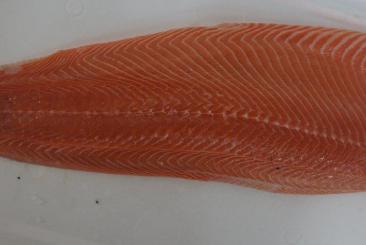 Read More
Read MoreSalmon is a popular food. Classified as an oily fish, salmon is considered to be healthy due to the fish's high protein, high omega-3 fatty acids, and high vitamin D content. Salmon is also a source of cholesterol, with a range of 23–214 mg/100 g depending on the species. According to reports in the journal Science, farmed salmon may contain high levels of dioxins.[medical citation needed] PCB (polychlorinated biphenyl) levels may be up to eight times higher in farmed salmon than in wild salmon, but still well below levels considered dangerous.[88][89] Nonetheless, according to a 2006 study published in the Journal of the American Medical Association, the benefits of eating even farmed salmon still outweigh any risks imposed by contaminants.[90] Farmed salmon has a high omega 3 fatty acid content comparable to wild salmon. The type of omega-3 present may not be a factor for other important health functions.
Salmon flesh is generally orange to red, although white-fleshed wild salmon with white-black skin colour occurs. The natural colour of salmon results from carotenoid pigments, largely astaxanthin, but also canthaxanthin, in the flesh. Wild salmon get these carotenoids from eating krill and other tiny shellfish.
The vast majority of Atlantic salmon available around the world are farmed (almost 99%), whereas the majority of Pacific salmon are wild-caught (greater than 80%). Canned salmon in the US is usually wild Pacific catch, though some farmed salmon is available in canned form. Smoked salmon is another popular preparation method, and can either be hot or cold smoked. Lox can refer to either cold-smoked salmon or salmon cured in a brine solution (also called gravlax). Traditional canned salmon includes some skin (which is harmless) and bone (which adds calcium). Skinless and boneless canned salmon is also available.
Raw salmon flesh may contain Anisakis nematodes, marine parasites that cause anisakiasis. Before the availability of refrigeration, the Japanese did not consume raw salmon. Salmon and salmon roe have only recently come into use in making sashimi (raw fish) and sushi.
To the Indigenous peoples of the Pacific Northwest Coast, salmon is considered a vital part of the diet. Specifically, the indigenous peoples of Haida Gwaii, located near former Queen Charlotte Island in British Columbia, rely on salmon as one of their main sources of food, although many other bands have fished Pacific waters for centuries. Salmon are not only ancient and unique, but it is important because it is expressed in culture, art forms, and ceremonial feasts. Annually, salmon spawn in Haida, feeding on everything on the way upstream and down. In Haida, salmon is referred to as "tsiin" There are many forms of preparing it including: smoking, baking, frying, making soup, or candied salmon
Historically, there has always been enough salmon, as people would not overfish, and only took what they needed. In 2003, a report on First Nation participation in commercial fisheries, including salmon, commissioned by BC’s Ministry of Agriculture, Food and Fisheries found that there were 595 First Nation-owned and operated commercial vessels in the province. Of those vessels, First Nations’ members owned 564. However, employment within the industry has decreased overall by 50% in the last decade, with 8,142 registered commercial fishermen in 2003. This has affected employment for many fisherman, who rely on salmon as a source of income.
Black bears also rely on salmon as food. The leftovers the bears leave behind are considered important nutrients for the forest, such as the soil, trees, and plants. In this sense, the salmon feed the forest and in return receive clean water and gravel in which to hatch and grow, sheltered from extremes of temperature and water flow in times of high and low rainfall. However, the condition of the salmon in Haida has been affected in recent decades. Due to logging and development, much of the salmon's habitat (i.e.: Ain River) has been destroyed, resulting in the fish being close to endangered. For residents, this has resulted in limits on catches, in turn, has affected families diets, and cultural events such as feasts. Some of the salmon systems in danger include: the Davidon, Naden, Mamim, and Mathers. It is clear that further protection is needed for salmon, such as their habitats, where logging commonly occurs. -
Swordfish loins 3500,
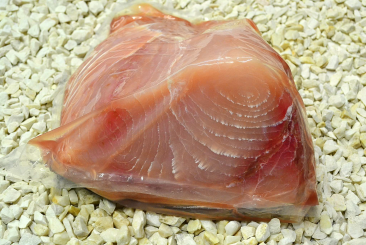 Read More
Read MoreSwordfish are classified as oily fish. Many sources, including the United States Food and Drug Administration, warn about potential toxicity from high levels of methylmercury in swordfish.The FDA recommends that young children, pregnant women, and women of child-bearing age not eat swordfish. (See mercury in fish for more details.)
The flesh of some swordfish can acquire an orange tint, reportedly from their diet of shrimp or other prey. Such fish are sold as "pumpkin swordfish", and command a premium over their whitish counterparts.
Swordfish is a particularly popular fish for cooking. Since swordfish are large animals, meat is usually sold as steaks, which are often grilled. Swordfish meat is relatively firm, and can be cooked in ways more fragile types of fish cannot (such as over a grill on skewers). The color of the flesh varies by diet, with fish caught on the East Coast of North America often being rosier. -
Swordfish loins 3+ frozen
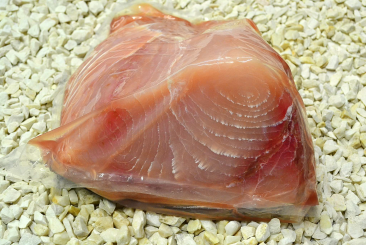 Read More
Read MoreSwordfish are classified as oily fish. Many sources, including the United States Food and Drug Administration, warn about potential toxicity from high levels of methylmercury in swordfish.The FDA recommends that young children, pregnant women, and women of child-bearing age not eat swordfish. (See mercury in fish for more details.)
The flesh of some swordfish can acquire an orange tint, reportedly from their diet of shrimp or other prey. Such fish are sold as "pumpkin swordfish", and command a premium over their whitish counterparts.
Swordfish is a particularly popular fish for cooking. Since swordfish are large animals, meat is usually sold as steaks, which are often grilled. Swordfish meat is relatively firm, and can be cooked in ways more fragile types of fish cannot (such as over a grill on skewers). The color of the flesh varies by diet, with fish caught on the East Coast of North America often being rosier. -
Hake fillets 100/200
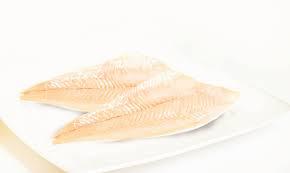 Read More
Read MoreThe highest demand for hake has been in Europe. Hake has been primarily divided into three principal levels—fresh, frozen, and frozen fillet. Fresh hake is mainly supplied by European production and imports. Frozen hake and frozen hake fillet are effectively supplied by imports and European processing companies.
Spain has the highest consumption of hake in Europe, with a yearly consumption of 6 kg/person. This works out to around half all hake eaten in Europe. Though Spanish consumption of hake and other fish declined in the last decade, hake still accounts for about one third of total fish consumption there. Other countries that eat a lot of hake include France, Italy, and Portugal.
In Spain, fresh hake are mostly purchased by restaurants through retailers. Nonetheless, processed hake products are distributed by hake wholesalers. Fishmongers, public markets and hypermarkets sell hake in various forms: frozen fillet, fillet skin-on, fillet skin-off, etc.
In France, fish are generally purchased in supermarkets. Due to insufficient European hake, French wholesalers purchase fresh hake from external countries such as Argentina and Namibia, and then export them to Spain. Fresh hake is mostly exported to Spain.
In Italy, hotels, restaurants, supermarkets, and institutional purchasers purchase much seafood. However, retailers and wholesalers purchase most frozen hake fillets to sell in markets. -
Zander gutted 600/2000
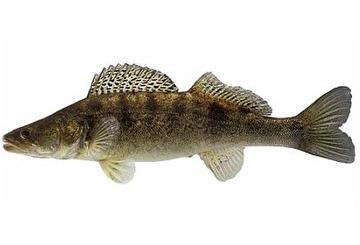 Read More
Read MoreThe zander is considered one of the most valuable food fish, native to Europe. It is esteemed for its light, firm but tender meat with few bones and a delicate flavour. Although it is not generally bred for food, its adaptability makes zander fishery quite sustainable. Indeed, in some regions release of young zanders is restricted, as natural stocks already provide a sufficient supply for the market, while boosting the population of this large predator would have an adverse effect on the zander's food fishes. Zander is especially well suited for fish fillets, sushi and sashimi. It can also be served whole, baked, smoked or cooked. In some culinary circles, zander is appreciated even higher than salmon. Even the offals can be cooked into consommé.
In 2004, it was revealed that some restaurants in the Minneapolis-St. Paul area of Minnesota in the United States were serving imported zander instead of the closely related North American walleye (the state fish, and a popular food in the region). While zander and walleye are almost indistinguishable by taste, the restaurants were selling the European fish under the name "walleye", which is an illegal practice. An investigation by the U.S. Food and Drug Administration followed.
In Ohio many restaurants were caught using juvenile Zander fillets in the 40 to 80 gram range in place of Lake Erie Yellow Perch. Shortages on the availability of Perch along with skyrocketing prices caused wholesalers and restaurants to use the juvenile Zander also known as Pike Perch fillets.
In Poland, this fish is popular and regarded as a delicacy, but the difficulty in catching it makes it expensive. It is most commonly baked with a trace of butter.
In Finland, as a conservation measure, law regulates the minimum size of zander considered mature enough to be eaten. Zander is popular for its taste and its tendency to be picky with its prey, making it harder to catch than many other fish. Zander also tend to chase their prey before striking. When striking a fishing lure, it fights by pulling backwards, giving the impression that there is a big stone attached to the fishing line. Because zander is not as good in striking as pike, it prefers slower, even wounded fish; a lure moving too fast won't get the zander's attention. On the other hand, anecdotal evidence suggests that zander do not attack lures that are moving too slowly either.
Wikinews has related news: 'Monster' fish killed in Swiss lake after biting swimmers
In July 2009 in Switzerland, a zander attacked tourists in Lake Maggiore, sending two people to the emergency room; the worst cut inflicted was about 10 centimeters long. The 70-cm 8-kg fish was later caught by the local police who cooked it and offered it to the tourists for the trouble it caused. It is very unusual for zander to attack humans. -
Zander ffillet with skin
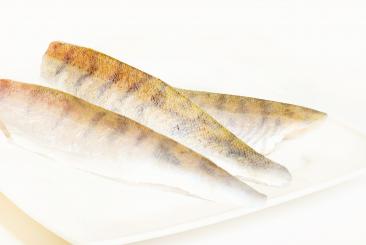 Read More
Read MoreThe zander is considered one of the most valuable food fish, native to Europe. It is esteemed for its light, firm but tender meat with few bones and a delicate flavour. Although it is not generally bred for food, its adaptability makes zander fishery quite sustainable. Indeed, in some regions release of young zanders is restricted, as natural stocks already provide a sufficient supply for the market, while boosting the population of this large predator would have an adverse effect on the zander's food fishes. Zander is especially well suited for fish fillets, sushi and sashimi. It can also be served whole, baked, smoked or cooked. In some culinary circles, zander is appreciated even higher than salmon. Even the offals can be cooked into consommé.
In 2004, it was revealed that some restaurants in the Minneapolis-St. Paul area of Minnesota in the United States were serving imported zander instead of the closely related North American walleye (the state fish, and a popular food in the region). While zander and walleye are almost indistinguishable by taste, the restaurants were selling the European fish under the name "walleye", which is an illegal practice. An investigation by the U.S. Food and Drug Administration followed.
In Ohio many restaurants were caught using juvenile Zander fillets in the 40 to 80 gram range in place of Lake Erie Yellow Perch. Shortages on the availability of Perch along with skyrocketing prices caused wholesalers and restaurants to use the juvenile Zander also known as Pike Perch fillets.
In Poland, this fish is popular and regarded as a delicacy, but the difficulty in catching it makes it expensive. It is most commonly baked with a trace of butter.
In Finland, as a conservation measure, law regulates the minimum size of zander considered mature enough to be eaten. Zander is popular for its taste and its tendency to be picky with its prey, making it harder to catch than many other fish. Zander also tend to chase their prey before striking. When striking a fishing lure, it fights by pulling backwards, giving the impression that there is a big stone attached to the fishing line. Because zander is not as good in striking as pike, it prefers slower, even wounded fish; a lure moving too fast won't get the zander's attention. On the other hand, anecdotal evidence suggests that zander do not attack lures that are moving too slowly either.
Wikinews has related news: 'Monster' fish killed in Swiss lake after biting swimmers
In July 2009 in Switzerland, a zander attacked tourists in Lake Maggiore, sending two people to the emergency room; the worst cut inflicted was about 10 centimeters long. The 70-cm 8-kg fish was later caught by the local police who cooked it and offered it to the tourists for the trouble it caused. It is very unusual for zander to attack humans. -
European pilchard 45/50
Read MoreSardines are commonly consumed by human beings. Fresh sardines are often grilled, pickled or smoked, or preserved in cans.
Sardines are rich in vitamins and minerals. A small serving of sardines once a day can provide 13 percent of vitamin B2; roughly one-quarter of niacin; and about 150 percent of the recommended daily value of vitamin B12. All B vitamins help to support proper nervous system function and are used for energy metabolism, or converting food into energy. Also, sardines are high in the major minerals such as phosphorus, calcium, potassium, and some trace minerals including iron and selenium. Sardines are also a natural source of marine omega-3 fatty acids, which may reduce the occurrence of cardiovascular disease. Recent studies suggest that regular consumption of omega-3 fatty acids reduces the likelihood of developing Alzheimer's disease. These fatty acids can also lower blood sugar levels. They are also a good source of vitamin D, calcium, vitamin B12, and protein.
Because they are low in the food chain, sardines are very low in contaminants such as mercury, relative to other fish commonly eaten by humans. -
Sole 170/200
Read MoreSole is a fish belonging to several families. Generally speaking, they are members of the family Soleidae, but, outside Europe, the name sole is also applied to various other similar flatfish, especially other members of the sole suborder Soleoidei as well as members of the flounder family. In European cookery, there are several species which may be considered true soles, but the common or Dover sole Solea solea, often simply called the sole, is the most esteemed and most widely available.
-
Sole 200/300
Read MoreSole is a fish belonging to several families. Generally speaking, they are members of the family Soleidae, but, outside Europe, the name sole is also applied to various other similar flatfish, especially other members of the sole suborder Soleoidei as well as members of the flounder family. In European cookery, there are several species which may be considered true soles, but the common or Dover sole Solea solea, often simply called the sole, is the most esteemed and most widely available.
-
Sole 350/400
Read MoreSole is a fish belonging to several families. Generally speaking, they are members of the family Soleidae, but, outside Europe, the name sole is also applied to various other similar flatfish, especially other members of the sole suborder Soleoidei as well as members of the flounder family. In European cookery, there are several species which may be considered true soles, but the common or Dover sole Solea solea, often simply called the sole, is the most esteemed and most widely available.
-
Sole 350/400
 Read More
Read MoreSole is a fish belonging to several families. Generally speaking, they are members of the family Soleidae, but, outside Europe, the name sole is also applied to various other similar flatfish, especially other members of the sole suborder Soleoidei as well as members of the flounder family. In European cookery, there are several species which may be considered true soles, but the common or Dover sole Solea solea, often simply called the sole, is the most esteemed and most widely available.
-
Sole 400/500
 Read More
Read MoreSole is a fish belonging to several families. Generally speaking, they are members of the family Soleidae, but, outside Europe, the name sole is also applied to various other similar flatfish, especially other members of the sole suborder Soleoidei as well as members of the flounder family. In European cookery, there are several species which may be considered true soles, but the common or Dover sole Solea solea, often simply called the sole, is the most esteemed and most widely available.
-
Tuna loins 3500
Read MoreA tuna is a saltwater fish that belongs to the tribe Thunnini, a sub-grouping of the mackerel family (Scombridae) – which together with the tunas, also includes the bonitos, mackerels, and Spanish mackerels. Thunnini comprises fifteen species across five genera,[1] the sizes of which vary greatly, ranging from the bullet tuna (max. length: 50 cm (1.6 ft), weight: 1.8 kg (4 lb)) up to the Atlantic bluefin tuna (max. length: 4.6 m (15 ft), weight: 684 kg (1,508 lb)). The bluefin averages 2 m (6.6 ft), and is believed to live for up to 50 years.
Tuna and mackerel sharks are the only species of fish that can maintain a body temperature higher than that of the surrounding water. An active and agile predator, the tuna has a sleek, streamlined body, and is among the fastest-swimming pelagic fish – the yellowfin tuna, for example, is capable of speeds of up to 75 km/h (47 mph).[2] Found in warm seas, it is extensively fished commercially, and is popular as a game fish. As a result of over-fishing, stocks of some tuna species such as the southern bluefin tuna have been reduced dangerously close to the point of extinction -
Tuna loins regular
Read MoreA tuna is a saltwater fish that belongs to the tribe Thunnini, a sub-grouping of the mackerel family (Scombridae) – which together with the tunas, also includes the bonitos, mackerels, and Spanish mackerels. Thunnini comprises fifteen species across five genera,[1] the sizes of which vary greatly, ranging from the bullet tuna (max. length: 50 cm (1.6 ft), weight: 1.8 kg (4 lb)) up to the Atlantic bluefin tuna (max. length: 4.6 m (15 ft), weight: 684 kg (1,508 lb)). The bluefin averages 2 m (6.6 ft), and is believed to live for up to 50 years.
Tuna and mackerel sharks are the only species of fish that can maintain a body temperature higher than that of the surrounding water. An active and agile predator, the tuna has a sleek, streamlined body, and is among the fastest-swimming pelagic fish – the yellowfin tuna, for example, is capable of speeds of up to 75 km/h (47 mph).[2] Found in warm seas, it is extensively fished commercially, and is popular as a game fish. As a result of over-fishing, stocks of some tuna species such as the southern bluefin tuna have been reduced dangerously close to the point of extinction -
Tuna loins
Read MoreA tuna is a saltwater fish that belongs to the tribe Thunnini, a sub-grouping of the mackerel family (Scombridae) – which together with the tunas, also includes the bonitos, mackerels, and Spanish mackerels. Thunnini comprises fifteen species across five genera,[1] the sizes of which vary greatly, ranging from the bullet tuna (max. length: 50 cm (1.6 ft), weight: 1.8 kg (4 lb)) up to the Atlantic bluefin tuna (max. length: 4.6 m (15 ft), weight: 684 kg (1,508 lb)). The bluefin averages 2 m (6.6 ft), and is believed to live for up to 50 years.
Tuna and mackerel sharks are the only species of fish that can maintain a body temperature higher than that of the surrounding water. An active and agile predator, the tuna has a sleek, streamlined body, and is among the fastest-swimming pelagic fish – the yellowfin tuna, for example, is capable of speeds of up to 75 km/h (47 mph).[2] Found in warm seas, it is extensively fished commercially, and is popular as a game fish. As a result of over-fishing, stocks of some tuna species such as the southern bluefin tuna have been reduced dangerously close to the point of extinction -
Tuna loins-Center Cut
Read MoreA tuna is a saltwater fish that belongs to the tribe Thunnini, a sub-grouping of the mackerel family (Scombridae) – which together with the tunas, also includes the bonitos, mackerels, and Spanish mackerels. Thunnini comprises fifteen species across five genera,[1] the sizes of which vary greatly, ranging from the bullet tuna (max. length: 50 cm (1.6 ft), weight: 1.8 kg (4 lb)) up to the Atlantic bluefin tuna (max. length: 4.6 m (15 ft), weight: 684 kg (1,508 lb)). The bluefin averages 2 m (6.6 ft), and is believed to live for up to 50 years.
Tuna and mackerel sharks are the only species of fish that can maintain a body temperature higher than that of the surrounding water. An active and agile predator, the tuna has a sleek, streamlined body, and is among the fastest-swimming pelagic fish – the yellowfin tuna, for example, is capable of speeds of up to 75 km/h (47 mph).[2] Found in warm seas, it is extensively fished commercially, and is popular as a game fish. As a result of over-fishing, stocks of some tuna species such as the southern bluefin tuna have been reduced dangerously close to the point of extinction -
Sashimi tuna
Read MoreA tuna is a saltwater fish that belongs to the tribe Thunnini, a sub-grouping of the mackerel family (Scombridae) – which together with the tunas, also includes the bonitos, mackerels, and Spanish mackerels. Thunnini comprises fifteen species across five genera,[1] the sizes of which vary greatly, ranging from the bullet tuna (max. length: 50 cm (1.6 ft), weight: 1.8 kg (4 lb)) up to the Atlantic bluefin tuna (max. length: 4.6 m (15 ft), weight: 684 kg (1,508 lb)). The bluefin averages 2 m (6.6 ft), and is believed to live for up to 50 years.
Tuna and mackerel sharks are the only species of fish that can maintain a body temperature higher than that of the surrounding water. An active and agile predator, the tuna has a sleek, streamlined body, and is among the fastest-swimming pelagic fish – the yellowfin tuna, for example, is capable of speeds of up to 75 km/h (47 mph).[2] Found in warm seas, it is extensively fished commercially, and is popular as a game fish. As a result of over-fishing, stocks of some tuna species such as the southern bluefin tuna have been reduced dangerously close to the point of extinction -
Sashimi tuna 3500
Read MoreA tuna is a saltwater fish that belongs to the tribe Thunnini, a sub-grouping of the mackerel family (Scombridae) – which together with the tunas, also includes the bonitos, mackerels, and Spanish mackerels. Thunnini comprises fifteen species across five genera,[1] the sizes of which vary greatly, ranging from the bullet tuna (max. length: 50 cm (1.6 ft), weight: 1.8 kg (4 lb)) up to the Atlantic bluefin tuna (max. length: 4.6 m (15 ft), weight: 684 kg (1,508 lb)). The bluefin averages 2 m (6.6 ft), and is believed to live for up to 50 years.
Tuna and mackerel sharks are the only species of fish that can maintain a body temperature higher than that of the surrounding water. An active and agile predator, the tuna has a sleek, streamlined body, and is among the fastest-swimming pelagic fish – the yellowfin tuna, for example, is capable of speeds of up to 75 km/h (47 mph).[2] Found in warm seas, it is extensively fished commercially, and is popular as a game fish. As a result of over-fishing, stocks of some tuna species such as the southern bluefin tuna have been reduced dangerously close to the point of extinction -
Tuna steak
Read MoreA tuna is a saltwater fish that belongs to the tribe Thunnini, a sub-grouping of the mackerel family (Scombridae) – which together with the tunas, also includes the bonitos, mackerels, and Spanish mackerels. Thunnini comprises fifteen species across five genera,[1] the sizes of which vary greatly, ranging from the bullet tuna (max. length: 50 cm (1.6 ft), weight: 1.8 kg (4 lb)) up to the Atlantic bluefin tuna (max. length: 4.6 m (15 ft), weight: 684 kg (1,508 lb)). The bluefin averages 2 m (6.6 ft), and is believed to live for up to 50 years.
Tuna and mackerel sharks are the only species of fish that can maintain a body temperature higher than that of the surrounding water. An active and agile predator, the tuna has a sleek, streamlined body, and is among the fastest-swimming pelagic fish – the yellowfin tuna, for example, is capable of speeds of up to 75 km/h (47 mph).[2] Found in warm seas, it is extensively fished commercially, and is popular as a game fish. As a result of over-fishing, stocks of some tuna species such as the southern bluefin tuna have been reduced dangerously close to the point of extinction -
Turbot 3000/4000
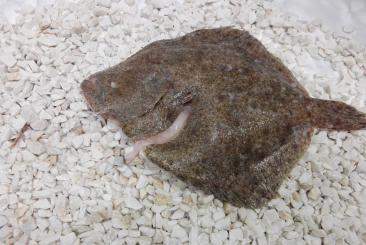 Read More
Read MoreTurbot is highly prized as a food fish for its delicate flavour, and is also known as brat, breet, britt or butt. It is a valuable commercial species, acquired through aquaculture and trawling. Turbot are farmed in Bulgaria, France, Spain, Portugal, Romania, Turkey, Chile, Norway, and China.[6] Turbot has a bright white flesh that retains this appearance when cooked. Like all flatfish, turbot yields four fillets with meatier topside portions that may be baked, poached, steamed, or pan-fried.
-
Turbot Baby
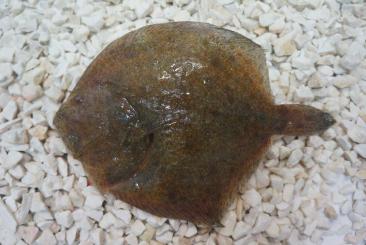 Read More
Read MoreTurbot is highly prized as a food fish for its delicate flavour, and is also known as brat, breet, britt or butt. It is a valuable commercial species, acquired through aquaculture and trawling. Turbot are farmed in Bulgaria, France, Spain, Portugal, Romania, Turkey, Chile, Norway, and China.[6] Turbot has a bright white flesh that retains this appearance when cooked. Like all flatfish, turbot yields four fillets with meatier topside portions that may be baked, poached, steamed, or pan-fried.
-
Turbot Baby 300/400
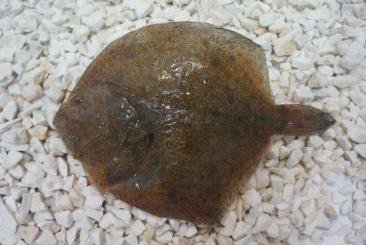 Read More
Read MoreTurbot is highly prized as a food fish for its delicate flavour, and is also known as brat, breet, britt or butt. It is a valuable commercial species, acquired through aquaculture and trawling. Turbot are farmed in Bulgaria, France, Spain, Portugal, Romania, Turkey, Chile, Norway, and China.[6] Turbot has a bright white flesh that retains this appearance when cooked. Like all flatfish, turbot yields four fillets with meatier topside portions that may be baked, poached, steamed, or pan-fried.
-
Turbot wild 1000/2000
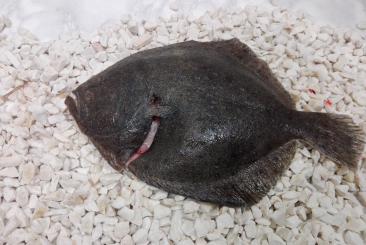 Read More
Read MoreTurbot is highly prized as a food fish for its delicate flavour, and is also known as brat, breet, britt or butt. It is a valuable commercial species, acquired through aquaculture and trawling. Turbot are farmed in Bulgaria, France, Spain, Portugal, Romania, Turkey, Chile, Norway, and China.[6] Turbot has a bright white flesh that retains this appearance when cooked. Like all flatfish, turbot yields four fillets with meatier topside portions that may be baked, poached, steamed, or pan-fried.
-
Lemon sole 300/500
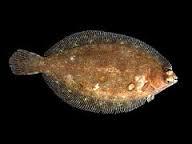 Read More
Read MoreLemon sole is a misnomer since the fish is neither a real sole, nor does it have the taste of lemon. It probably comes from the French name : "limande" or "sole limande". The French term "limande" may come from the French word "lime", it means "file" (tool used to smooth metal, wood, etc.), possibly referring to the texture of the fish's skin. Some other authors suggest that "limande" may also come from the French word "limon" (which means "silt").
-
Monkfish no head 500/1000
Read MoreThe head is of enormous size, broad, flat, and depressed, with the remainder of the body appearing merely like an appendage. The wide mouth extends all around the anterior circumference of the head, and both jaws are armed with bands of long, pointed teeth, which are inclined inwards, and can be temporarily depressed so as to offer no impediment to an object gliding towards the stomach, while still preventing its escape from the mouth. The pectoral and ventral fins are so articulated as to perform the functions of feet, the fish being enabled to "walk" on the bottom of the sea, where it generally hides itself in the sand or amongst seaweed. All around its head and also along the body, the skin bears fringed appendages resembling short fronds of seaweed. These structures, combined with the ability to change the colour of the body to match its surroundings, assists the fish greatly in concealing itself in its lurking places, which are selected for their abundance of prey.
Species of Lophius have three long filaments sprouting from the middle of their heads; these are the detached and modified three first spines of the anterior dorsal fin. As with all anglerfish species, the longest filament is the first, which terminates in an irregular growth of flesh, the esca (also referred to as the illicium), and is movable in all directions; this modified fin ray is used as a lure to attract other fish, which the monkfish then seize with their enormous jaws, devouring them whole. Whether the prey has been attracted to the lure or not is not strictly relevant, as the action of the jaws is an automatic reflex triggered by contact with the esca.
Monkfish, like most anglerfish, are also characterised by an enormously distensible stomach, which allows an individual monkfish to swallow prey fully as large as itself.[3][4] Monkfish grow to a length of more than 150 cm (4.9 ft); specimens of 100 cm (3.3 ft) are common. -
Monkfish whole 3000+
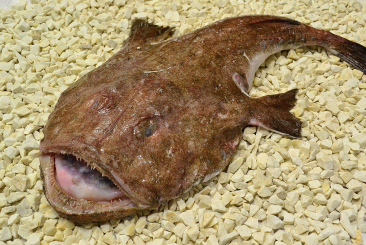 Read More
Read MoreThe head is of enormous size, broad, flat, and depressed, with the remainder of the body appearing merely like an appendage. The wide mouth extends all around the anterior circumference of the head, and both jaws are armed with bands of long, pointed teeth, which are inclined inwards, and can be temporarily depressed so as to offer no impediment to an object gliding towards the stomach, while still preventing its escape from the mouth. The pectoral and ventral fins are so articulated as to perform the functions of feet, the fish being enabled to "walk" on the bottom of the sea, where it generally hides itself in the sand or amongst seaweed. All around its head and also along the body, the skin bears fringed appendages resembling short fronds of seaweed. These structures, combined with the ability to change the colour of the body to match its surroundings, assists the fish greatly in concealing itself in its lurking places, which are selected for their abundance of prey.
Species of Lophius have three long filaments sprouting from the middle of their heads; these are the detached and modified three first spines of the anterior dorsal fin. As with all anglerfish species, the longest filament is the first, which terminates in an irregular growth of flesh, the esca (also referred to as the illicium), and is movable in all directions; this modified fin ray is used as a lure to attract other fish, which the monkfish then seize with their enormous jaws, devouring them whole. Whether the prey has been attracted to the lure or not is not strictly relevant, as the action of the jaws is an automatic reflex triggered by contact with the esca.
Monkfish, like most anglerfish, are also characterised by an enormously distensible stomach, which allows an individual monkfish to swallow prey fully as large as itself.[3][4] Monkfish grow to a length of more than 150 cm (4.9 ft); specimens of 100 cm (3.3 ft) are common. -
Monkfish whole 700/1000
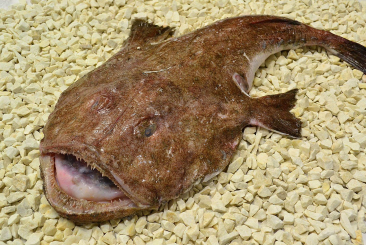 Read More
Read MoreThe head is of enormous size, broad, flat, and depressed, with the remainder of the body appearing merely like an appendage. The wide mouth extends all around the anterior circumference of the head, and both jaws are armed with bands of long, pointed teeth, which are inclined inwards, and can be temporarily depressed so as to offer no impediment to an object gliding towards the stomach, while still preventing its escape from the mouth. The pectoral and ventral fins are so articulated as to perform the functions of feet, the fish being enabled to "walk" on the bottom of the sea, where it generally hides itself in the sand or amongst seaweed. All around its head and also along the body, the skin bears fringed appendages resembling short fronds of seaweed. These structures, combined with the ability to change the colour of the body to match its surroundings, assists the fish greatly in concealing itself in its lurking places, which are selected for their abundance of prey.
Species of Lophius have three long filaments sprouting from the middle of their heads; these are the detached and modified three first spines of the anterior dorsal fin. As with all anglerfish species, the longest filament is the first, which terminates in an irregular growth of flesh, the esca (also referred to as the illicium), and is movable in all directions; this modified fin ray is used as a lure to attract other fish, which the monkfish then seize with their enormous jaws, devouring them whole. Whether the prey has been attracted to the lure or not is not strictly relevant, as the action of the jaws is an automatic reflex triggered by contact with the esca.
Monkfish, like most anglerfish, are also characterised by an enormously distensible stomach, which allows an individual monkfish to swallow prey fully as large as itself.[3][4] Monkfish grow to a length of more than 150 cm (4.9 ft); specimens of 100 cm (3.3 ft) are common. -
Whiting
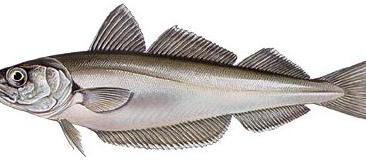 Read More
Read More -
Atlantic Cod loin without skin 1000+
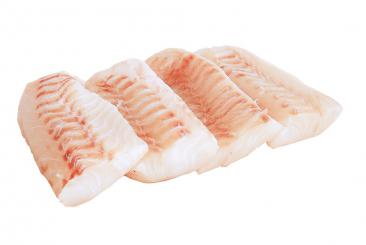 Read More
Read More -
Turbot 500/1000
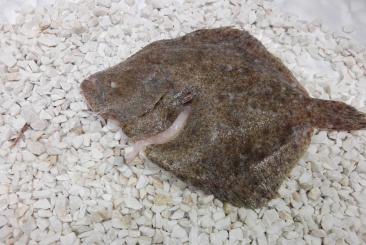 Read More
Read More
